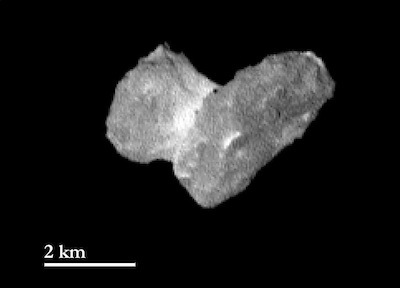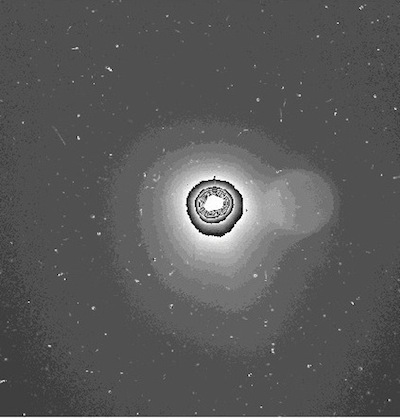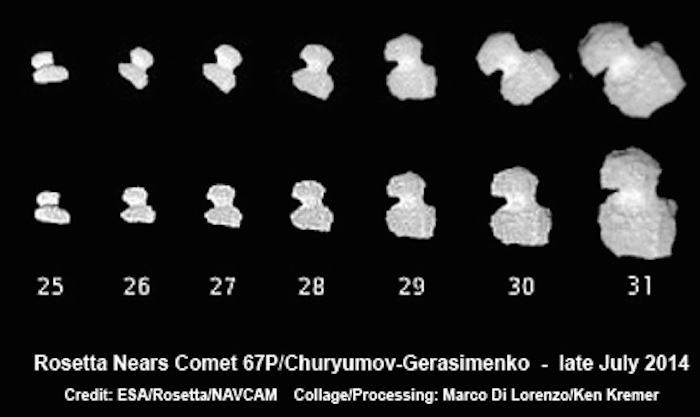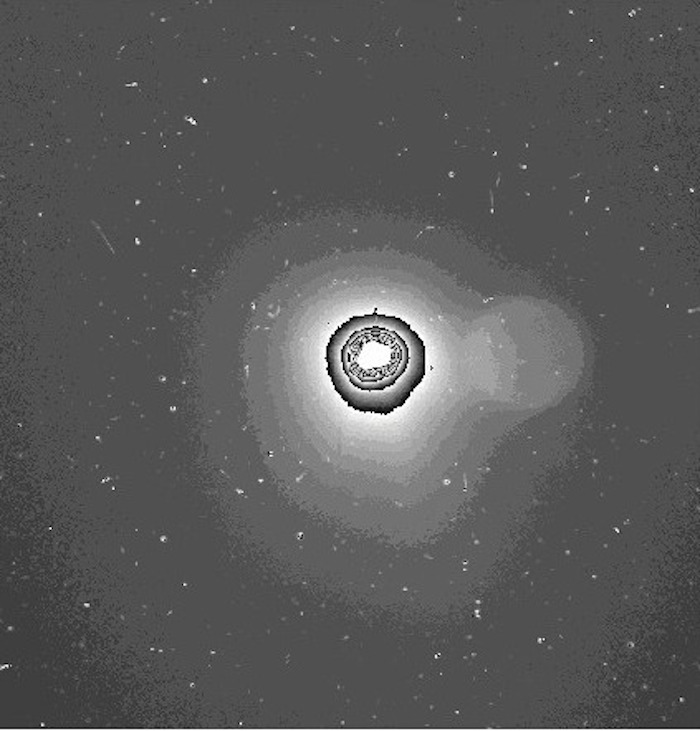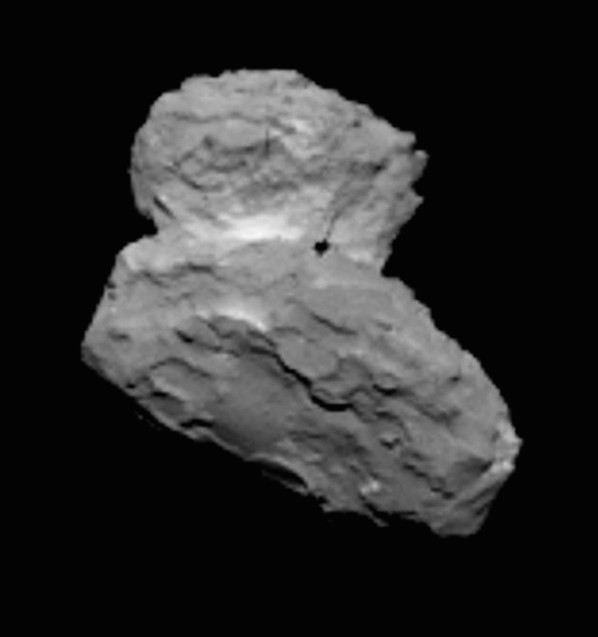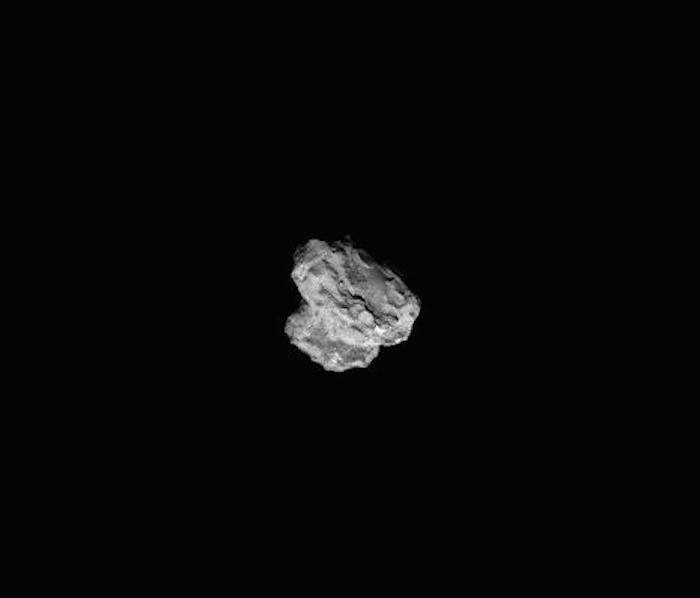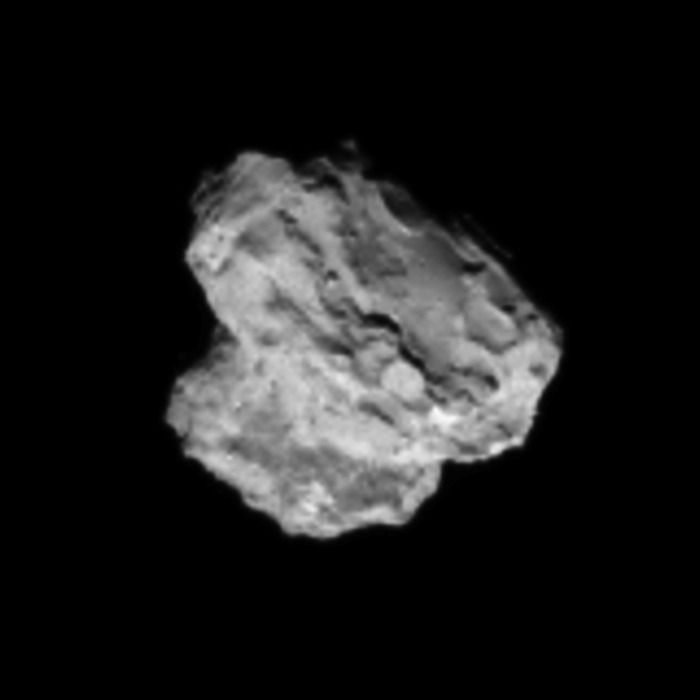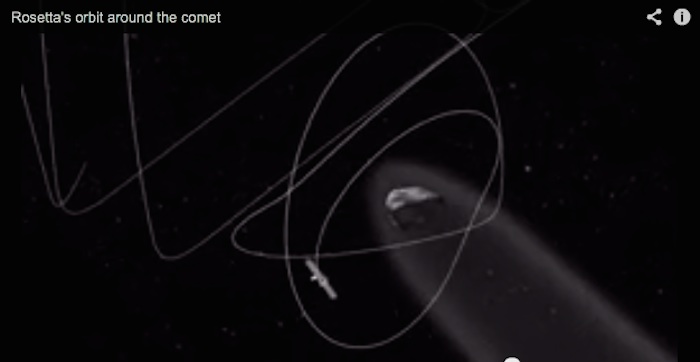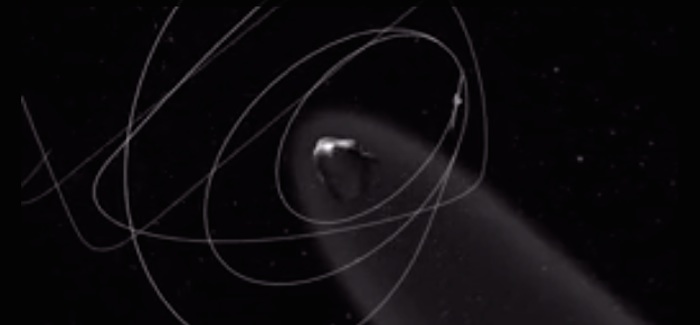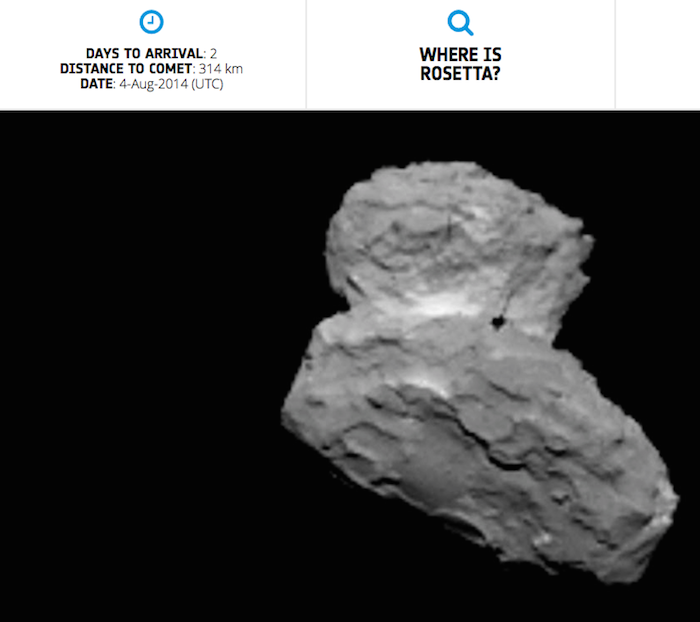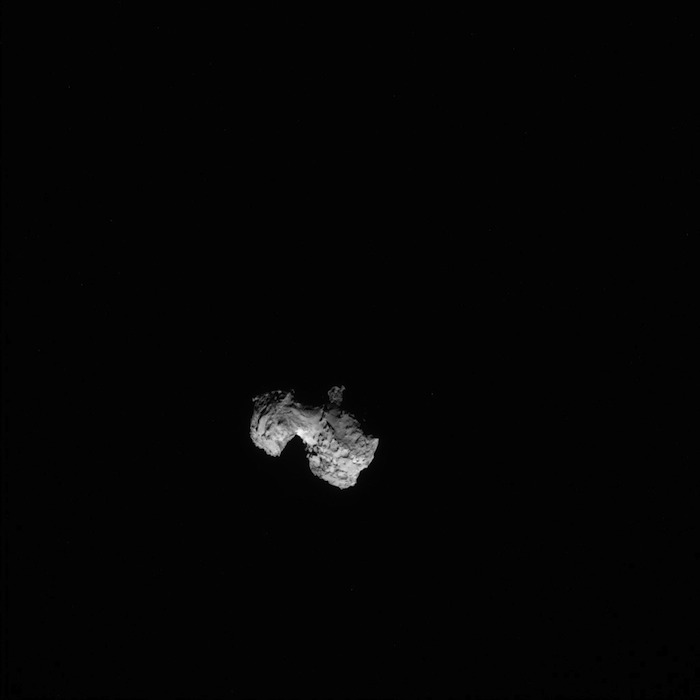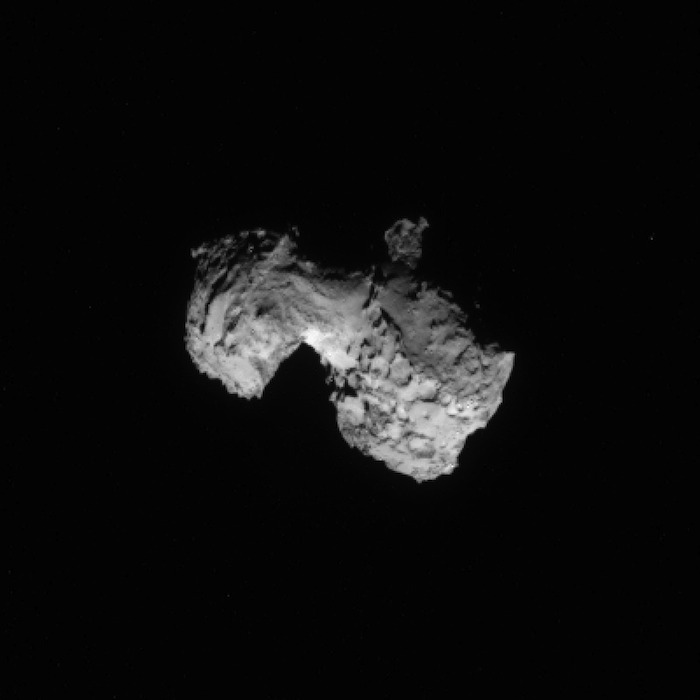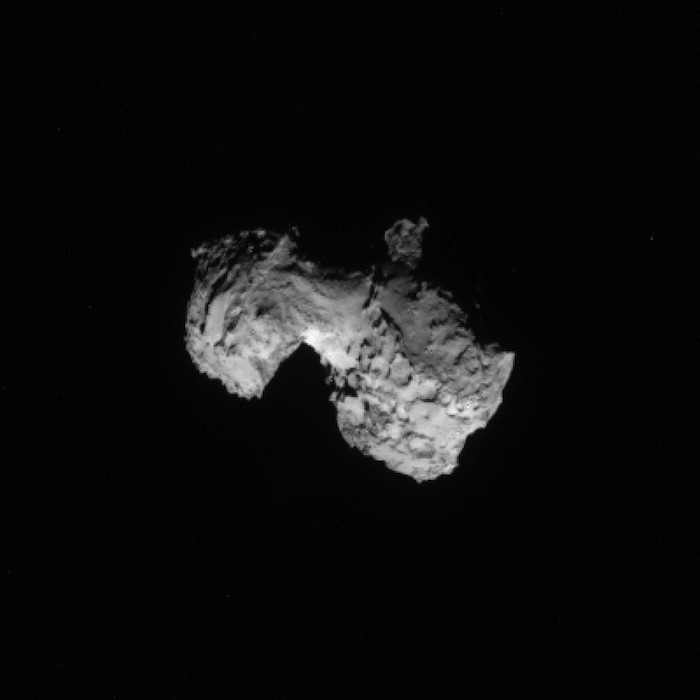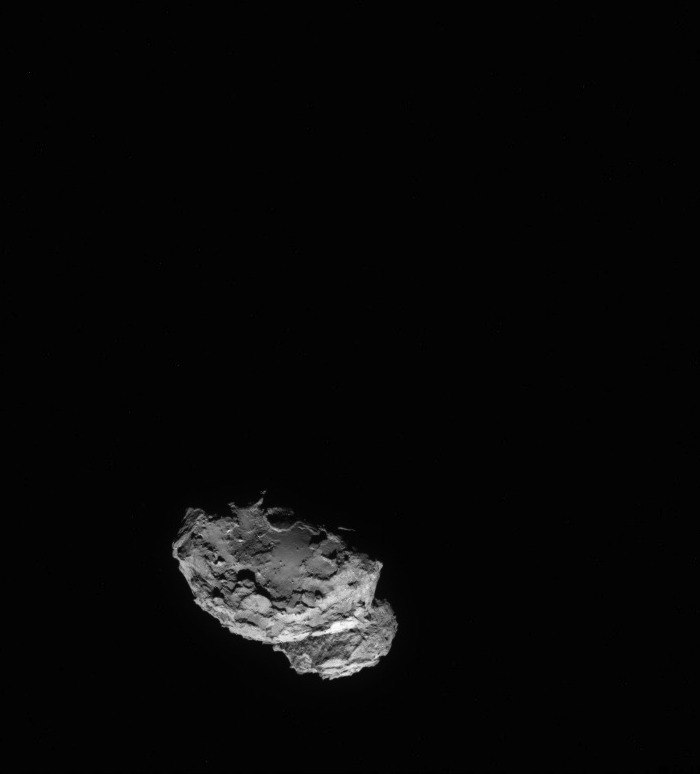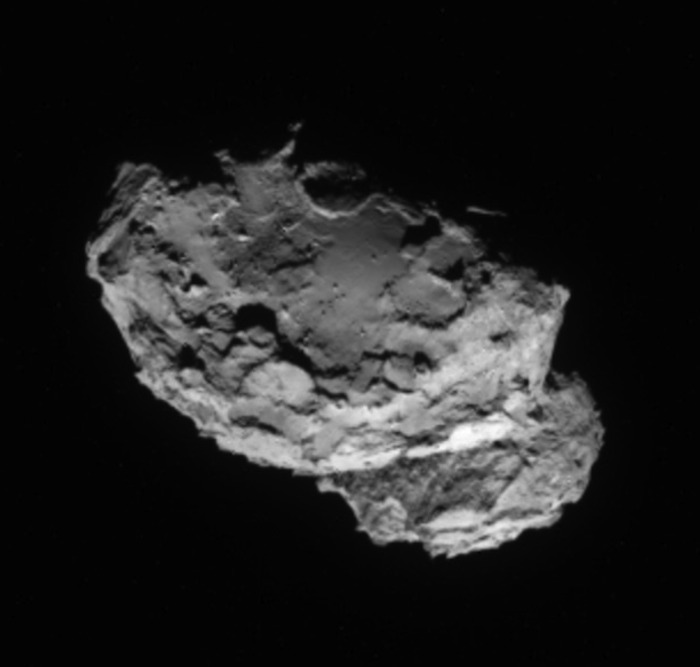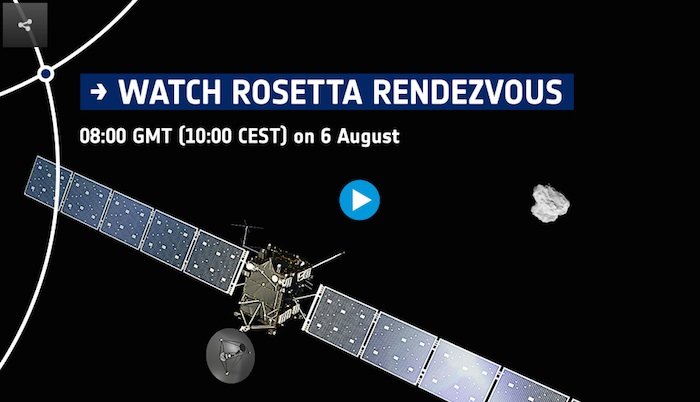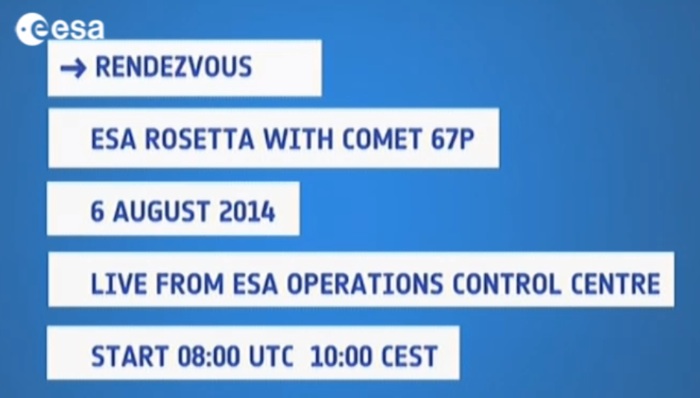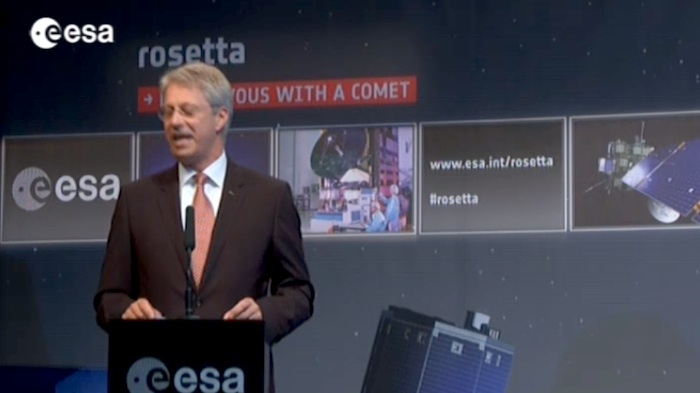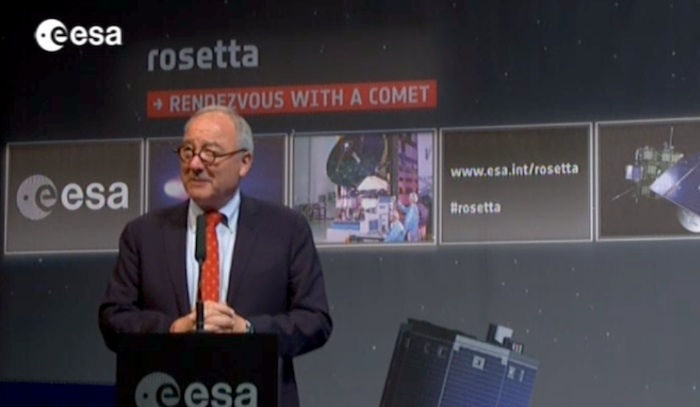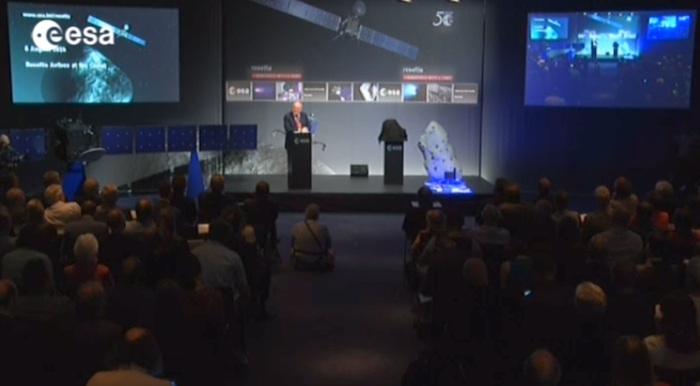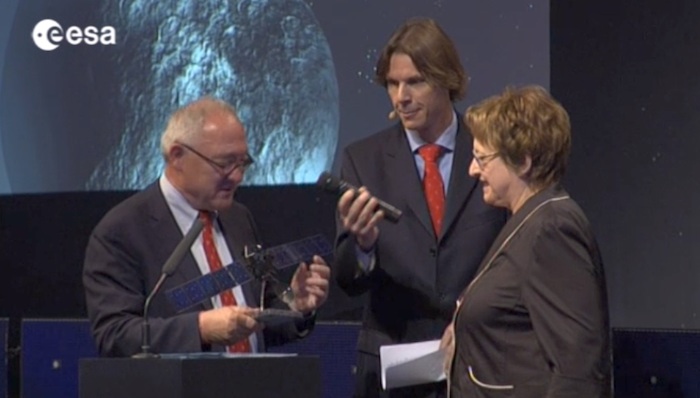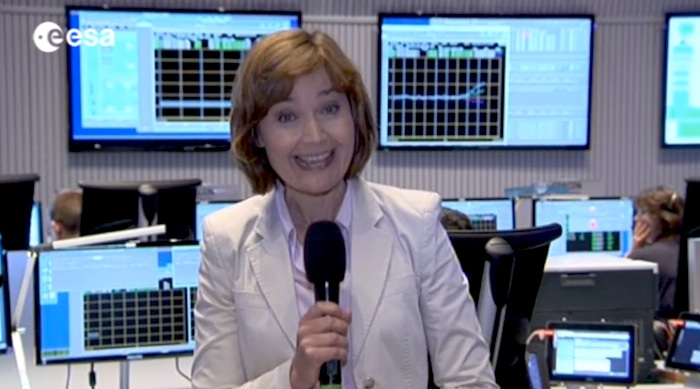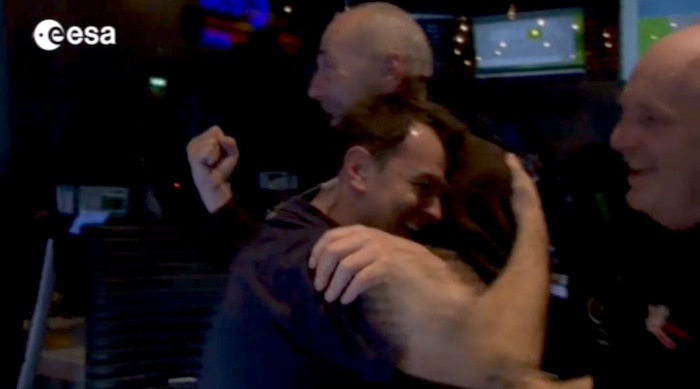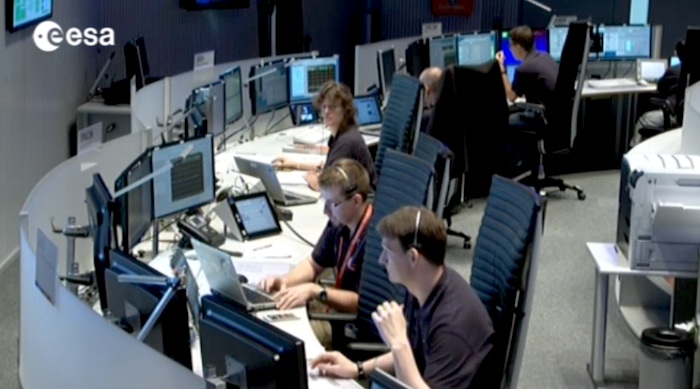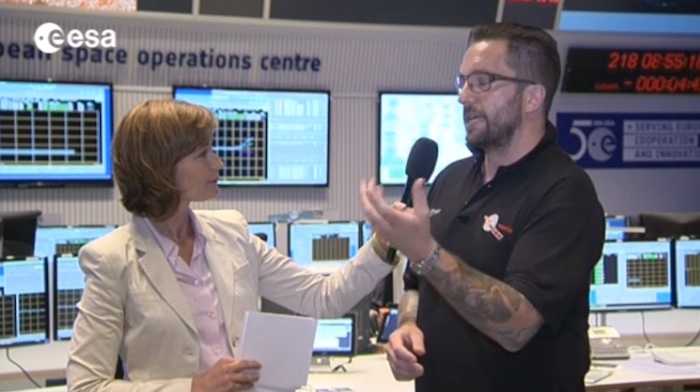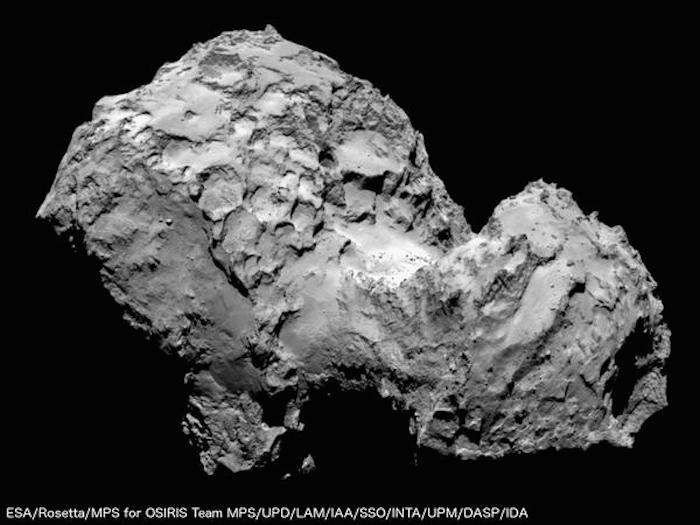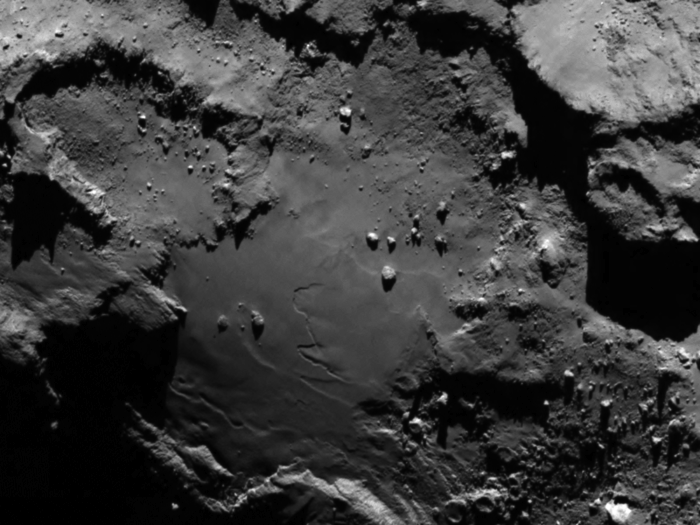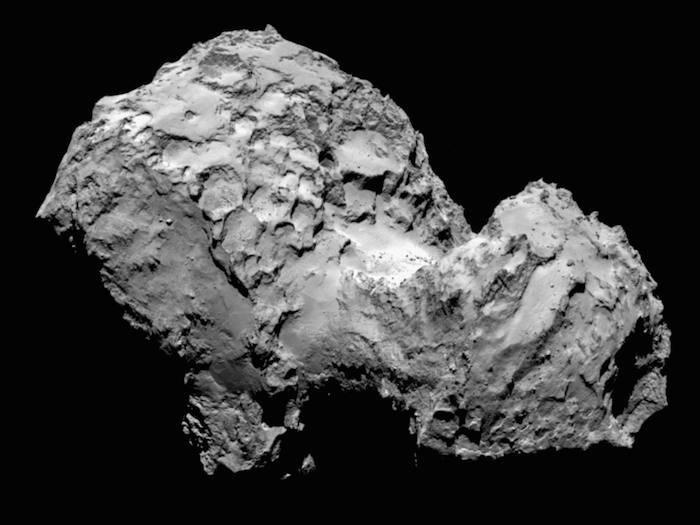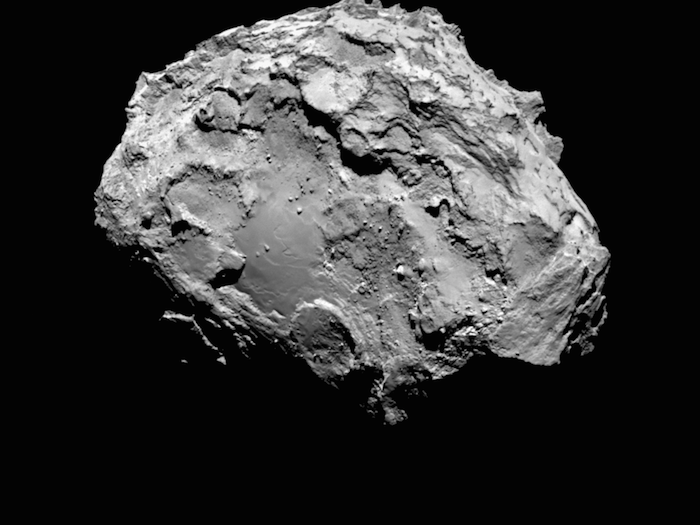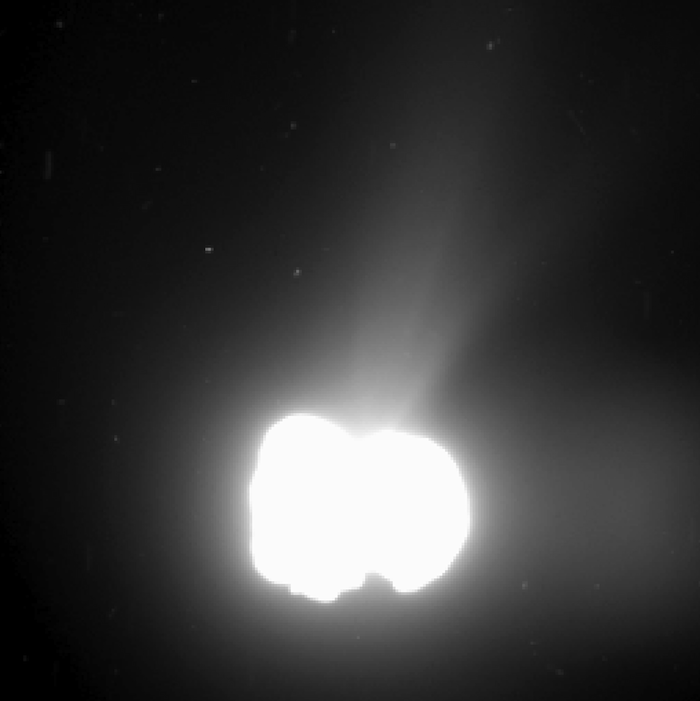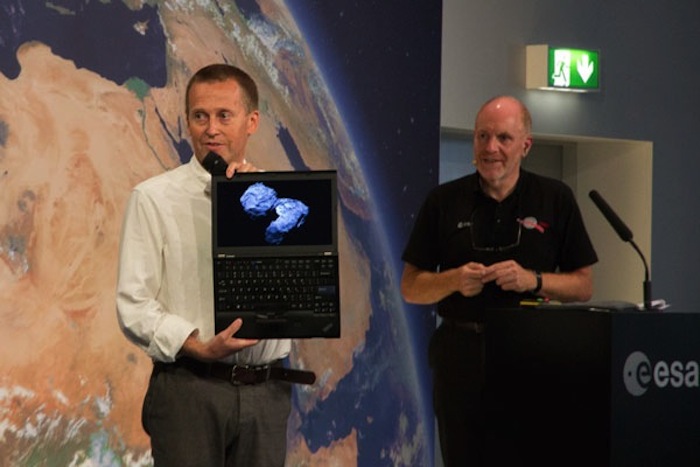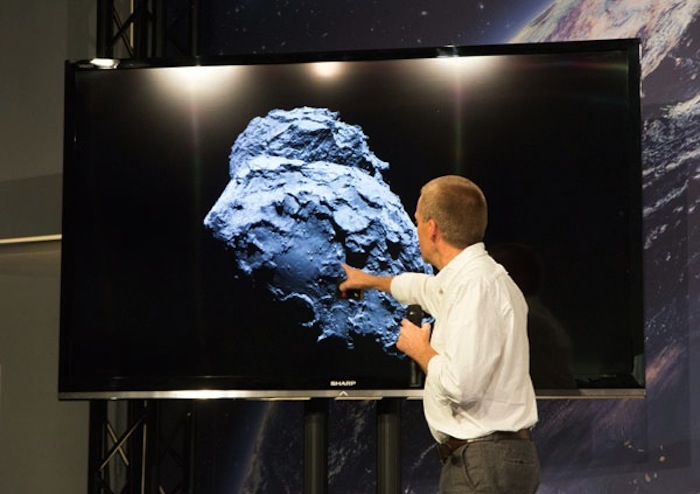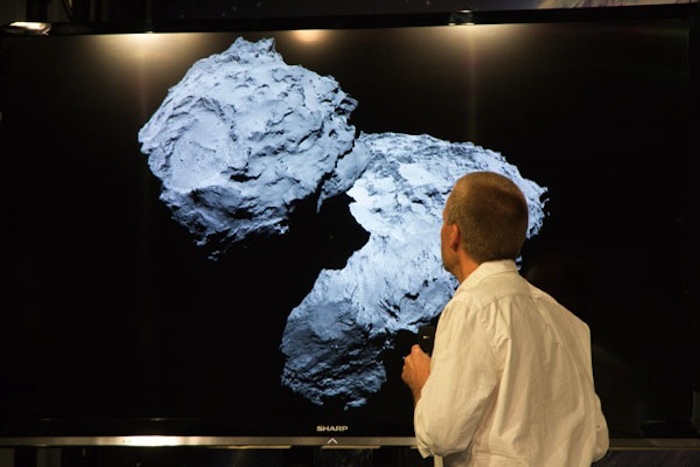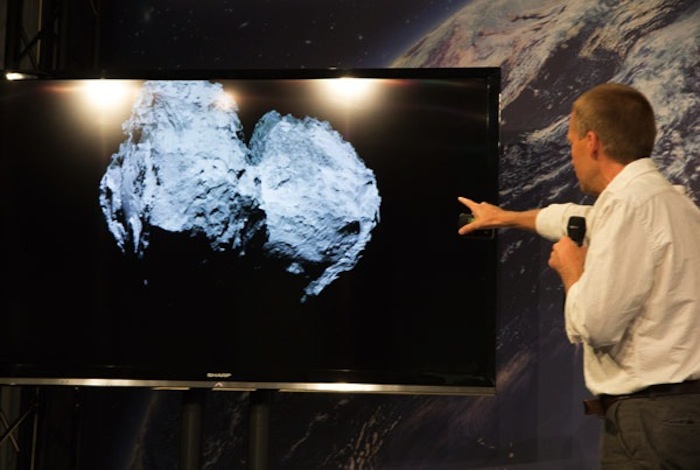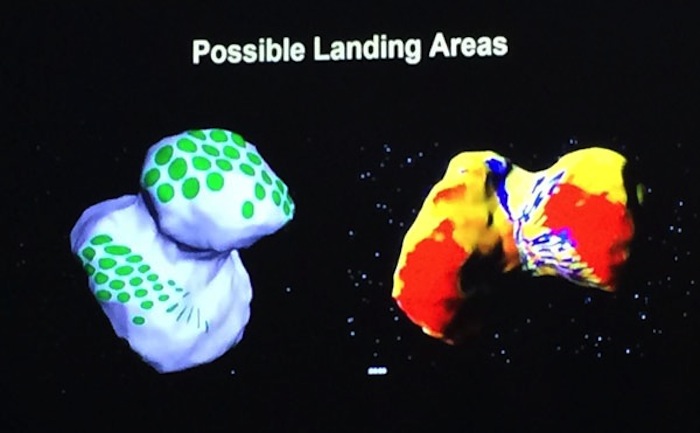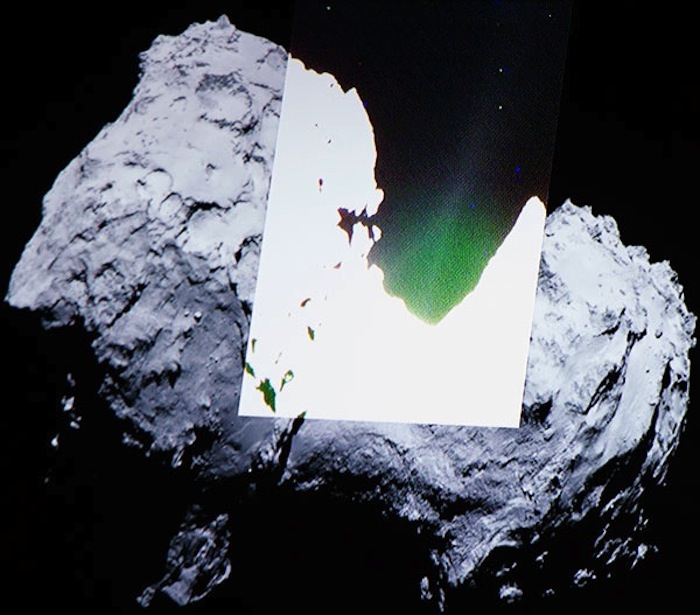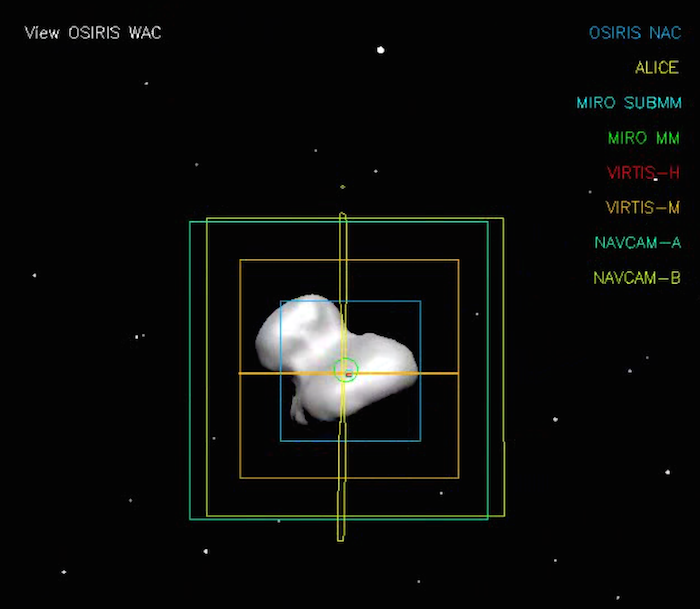Rosetta will arrive within 100 kilometers, or about 62 miles, of the comet Aug. 6. A minor rocket burn will put the probe in an unstable orbit around 67P/C-G, making Rosetta the first spacecraft to ever accomplish a controlled low-speed rendezvous with a comet.
As of Thursday, officials said Rosetta was less than 900 miles from the comet.
Imagery from Rosetta indicates the comet spins around once every 12.4 hours, according to scientists.
ESA plans to release the first close-up view the comet during a special event to celebrate the Aug. 6 rendezvous at Rosetta's control center in Darmstadt, Germany.
By September, scientists hope to identify a prime landing site for Philae, a small craft riding piggyback on Rosetta that will descend to the comet's surface in November.
.
Komet Churyumov-Gerasimenkos Oberfläche - zu heiß für Eis
.
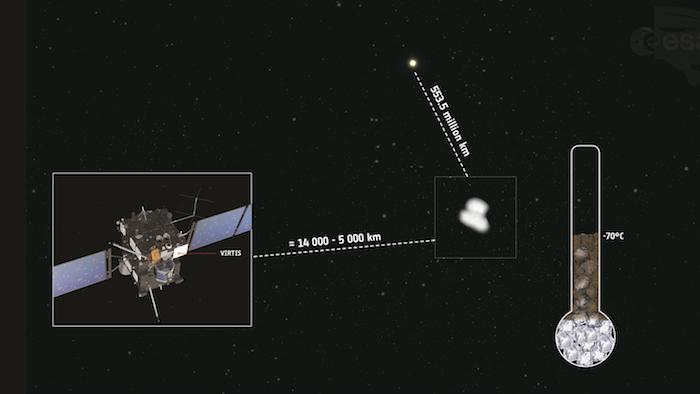
Was auf der Erde für Kälterekorde steht, ist für einen Kometen aus Staub und Eis noch längst nicht der Tiefpunkt: Gerade einmal minus 70 Grad Celsius haben die Wissenschaftler des Instruments VIRTIS als durchschnittliche Temperatur für den Kometen Churymov-Gerasimenko gemessen, auf dem im November 2014 das Landegerät Philae unter Leitung des Deutschen Zentrums für Luft- und Raumfahrt (DLR) aufsetzen soll. "Bei dieser Temperatur ist die Oberfläche des Kometen nicht vollständig mit einer Eisschicht bedeckt, sondern mit einem dunklen, staubigen Material", sagt DLR-Planetenforscherin Dr. Gabriele Arnold, die die deutschen wissenschaftlichen Beiträge zu diesem Experiment leitet. Gemessen wurde die Temperatur von der ESA-Sonde Rosetta aus, die am 6. August 2014 am Kometen ankommt.
Die Untersuchungen des Kometenkerns mit dem visuell-INFRAROTEN Spektrometer VIRTIS fingen im Juli dieses Jahres an. Zu diesem Zeitpunkt waren Sonde und Instrument noch zwischen 14.000 und 5000 Kilometer vom Zielkometen entfernt und so füllt der Komet nur wenige Pixel des Bildes aus. "Die Temperatur repräsentiert deshalb einen Mittelwert über die sichtbare Kometenoberfläche." Einzelne Regionen werden dabei nicht im Detail erfasst und können durchaus mit Eis bedeckt sein. Mit dem Durchschnittswert von minus 70 Grad Celsius liegt die Temperatur 20 bis 30 Grad über dem Wert, bei dem ein Komet komplett mit Eis bedeckt wäre. Die Wissenschaftler des VIRTIS-Teams gehen deshalb davon aus, dass die Oberfläche zum großen Teil mit einer Kruste aus dunklem, Staub bedeckt ist, die vom Sonnenlicht erwärmt wird und diese Energie im infraroten Wellenlängenbereich wieder abstrahlt. DLR-Kometenforscher Dr. Ekkehard Kührt, der ebenfalls an VIRTIS beteiligt ist, schlussfolgert aus ersten Modellrechnungen: "Die relativ hohen Temperaturen legen nahe, dass die staubige Oberfläche sehr rau sein muss".
Informationen für die Auswahl des Landeplatzes
"Mit der weiteren Annäherung der Rosetta-Sonde an den Kometen werden von nun an kontinuierlich räumlich immer höher aufgelöste Bilder und die entsprechenden Spektren aufgezeichnet", erläutert Dr. Gabriele Arnold. Dies wird es den Wissenschaftlern ermöglichen, die Feinstruktur der Oberfläche des Kerns, seine Zusammensetzung sowie physikalische Parameter wie Temperatur und thermische Trägheit des Oberflächenmaterials zu untersuchen. Spannend wird es dann vor ALLEM, wenn Rosetta mit dem Instrument VIRTIS an Bord den Kometen auf seinem Weg zur Sonne begleitet - noch ist der Komet Churyumov-Gerasimenko 543 Millionen Kilometer von der Sonne entfernt. Dann soll VIRTIS die Zusammensetzung des Kerns und die täglichen Veränderungen der Oberflächentemperatur in ausgewählten Regionen messen, um den Kometen und seinen Aufbau besser zu verstehen. VIRTIS wird Informationen über die thermalen Bedingungen und die stoffliche Struktur geeigneter Landeplätze liefern und gemeinsam mit anderen Instrumenten helfen, den besten Landeplatz auszuwählen.
Die Mission
ROSETTA ist eine Mission der ESA mit Beiträgen von ihren Mitgliedsstaaten und der der NASA. Rosettas Lander Philae wird von einem Konsortium unter der Leitung von DLR, MPS, CNES und ASI beigesteuert.
VIRTIS (Visible, InfraRed and Thermal Imaging Spectrometer) ist das visuell-infrarote Spektrometer an Bord der ESA-Sonde Rosetta. Es wird Informationen zur Zusammensetzung des Kometenkerns liefern und die Verteilung des Materials an der Oberfläche sowie der Gase und Moleküle in der Koma kartieren. VIRTIS wurde von einem Konsortium unter der wissenschaftlichen Leitung des Istituto di Astrofisica e Planetologia Spaziali of INAF in Rom (Italien) gebaut, das auch den wissenschaftlichen Betrieb leitet. Zum Konsortium gehören das Laboratoire d’Études Spatiales et d’Instrumentation en Astrophysique of the Observatoire in Paris (Frankreich) und das Institut für Planetenforschung des DLR (Deutschland). Die Entwicklung des Instruments wurde gefördert und koordiniert durch die nationalen Raumfahrtagenturen: Agenzia Spaziale Italiana (ASI, Italien), Centre National d’Études Spatiales (CNES, Frankreich) und des Deutschen Zentrum für Luft- und Raumfahrt (DLR, Deutschland).
Quelle: DLR
.
Update: 2.08.2014
.
Rosetta Closing in on Comet 67P/Churyumov-Gerasimenko after Decade Long Chase
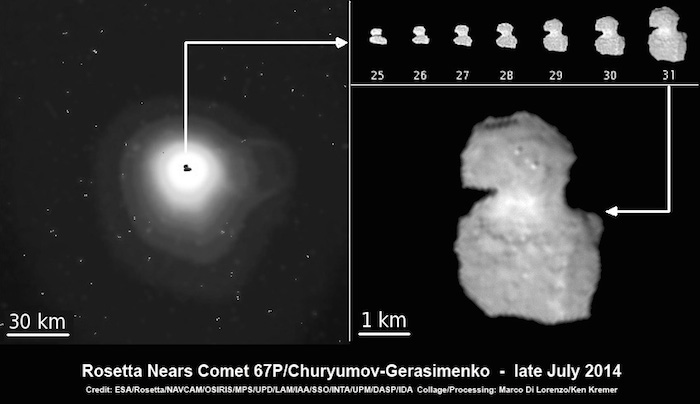
ESA’s Rosetta Spacecraft nears final approach to Comet 67P/Churyumov-Gerasimenko in late July 2014. This collage of imagery from Rosetta combines Navcam camera images at right taken nearing final approach from July 25 to July 31, 2014, with OSIRIS wide angle camera image at left of comet’s coma on July 25 from a distance of around 3000 km. On July 31 Rosetta had approached to within 1327 km. Images to scale and contrast enhanced to show further detail. CREDIT: ESA/Rosetta/NAVCAM/OSIRIS/MPS/UPD/LAM/IAA/SSO/INTA/UPM/DASP/IDA
Collage/Processing: Marco Di Lorenzo/Ken Kremer
.
The European Space Agency’s (ESA) ROSETTA spacecraft is at last rapidly closing in on its target destination, Comet 67P/Churyumov-Gerasimenko, after a decade long chase of 6.4 billion kilometers through interplanetary space. See imagery above and below.
As of today, Friday, August 1, ESA REPORTS that Rosetta has approached the ‘rubber ducky looking’ comet to within a distance of less than 1153 kilometers. That distance narrows with each passing moment as the speeding robotic probe moves closer and closer to the comet while looping around the sun at about 55,000 kilometers per hour (kph).
Rosetta is now just 5 days away from becoming Earth’s first probe ever to rendezvous and enter ORBIT around a comet.
See above our IMAGE collage of Rosetta nearing final approach with the spacecrafts most recent daily Navcam camera images, all taken within the past week starting on July 25 and including up to the most recently release image snapped on July 31. The navcam images are all to scale to give the sense of the spacecraft approaching the comet and revealing ever greater detail as it grows in apparent size in the cameras field of view.
The highest resolution navcam image yet of the two lobed comet – merged at a bright band – was taken on July 31 from a distance of 1327 kilometers and published within the past few hours by ESA today, Aug 1. It shows the best view yet of the surface features of the mysterious bright necked wanderer composed of primordial ice, rock, dust and more.
The Navcam collage is combined with an OSIRIS (OPTICAL, Spectroscopic, and Infrared Remote Imaging System) wide angle camera view of the comet and its asymmetric coma of ice and dust snapped on July 25 from a distance of around 3000 km, and with an exposure time of 300 seconds. The OSIRIS image covers an area of about 150 x 150 km (90 mi x 90 mi). The images have been contrast enhanced to bring out more detail.
Scientists speculate that the comets bright neck region could be caused by differences in material or grain size or topological effects.
Rosetta’s history making orbital feat is slated for Aug. 6 following the final short duration ORBIT insertion burns on Aug. 3 and Aug. 6 to place Rosetta into orbit at an altitude of about 100 kilometers (62 miles) where it will study and map the 4 kilometer wide comet for some 17 months.
The comet rotates around once every 12.7 hours.
.
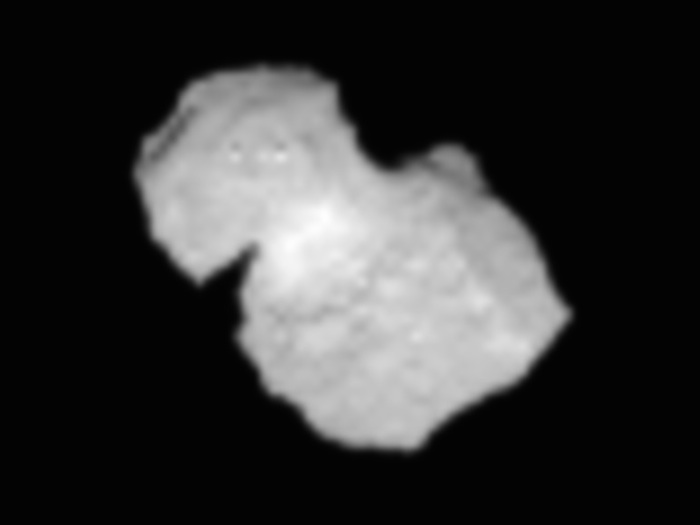
“If any glitches in space or on ground had delayed the most recent burns, orbital mechanics dictate that we’d only have had a matter of a few days to fix the problem, re-plan the burn and carry it out, otherwise we run the risk of missing the comet,” says Trevor Morley, a flight dynamics specialist at ESOC.
In November 2014 the Rosetta mothership will deploy the Philae science lander for the first ever attempt to land on a comet’s nucleus using harpoons to anchor itself to the surface.
As Rosetta edges closer on its final lap, engineers at mission control at the European Space Operations Centre (ESOC), in Darmstadt, Germany have commanded the probes navigation camera (navcam) to capture daily images while the other science instruments also collect measurements analyzing the comets physical characteristics and chemical composition in detail.
.
The probe has already discovered that the comet’s surface temperature is surprisingly warm at –70ºC, which is some 20–30ºC warmer than predicted. This indicates the surface is too hot to be covered in ice and must instead have a dark, dusty crust, says ESA.
Comet 67P/Churyumov-Gerasimenko is a short period comet some 555 million kilometres from the Sun at this time, about three times further away than Earth and located between the ORBITS of Jupiter and Mars.
You can watch the Aug. 6 orbital arrival live via a livestream TRANSMISSION from ESA’s spacecraft operations centre in Darmstadt, Germany.
While you were reading this the gap between the comet and ROSETTA closed to less than 1000 kilometers!
.
Quelle: UT
.
Update: 3.08.2014
.
COMET AT 1000 KM
.
ROSETTA sees the comet just five days before arrival.
This image was acquired 1 August at 04:48 CEST (02:48 UTC) by the OSIRIS Narrow Angle Camera on board ESA's Rosetta spacecraft. The distance was approximately 1000 km. Note that the dark spot is an artefact from the onboard CCD.
.
OSIRIS narrow angle camera view of 67P/C-G from a distance of 1000 km on 1 August 2014.
.
If this IMAGE is rotated approximately 150 degrees, the orientation of the comet is pretty close to that of the 1 August NAVCAM image (distance 1026 km), and thus the two images from the two cameras can be directly compared. NOTE that, similar to the dark spot artefact in this OSIRIS image, the 1 August NAVCAM image displays white/black artefact spots.
A nice update on a hot Saturday just four days before arrival – time to really get excited!
Quelle: ESA
.
Here's comet #67P from a distance of about 500 km with my NAVCAM yesterday
.
Crop from the 2 August processed image of comet 67P/Churyumov-Gerasimenko. CREDITS: ESA/Rosetta/NAVCAM
Quelle: ESA
.
Update: 4.08.2014
.
WHAT’S HAPPENING IN ROSETTA MISSION CONTROL TODAY
Yesterday’s ORBIT correction manoeuvre (OCM) – dubbed CATP for ‘Close Approach Trajectory – pre-Insertion’ – went off without problems, delivering the desired 3.2 m/s of speed decrease.
We now have just one final burn of around 1 m/s that will slow Rosetta and kick it onto the first of the comet orbit arcs (see video below). This will take place on Wednesday, which will also be celebrated as the official ‘arrival day’ at ESOC with a formal programme and media briefing (you can follow via webcast).
The Rosetta FLIGHT Control Team (FCT) are very busy, as today marks the first day in a new weekly work cycle that will see thruster burns taking place on Wed/Sun well into 2015.
Rosetta will, follow, at least for now, a three-legged triangular orbit that requires a small thruster burn at each APEX. The legs are about 100 km long and it will take Rosetta between three and four days to complete each one.
.
.
.
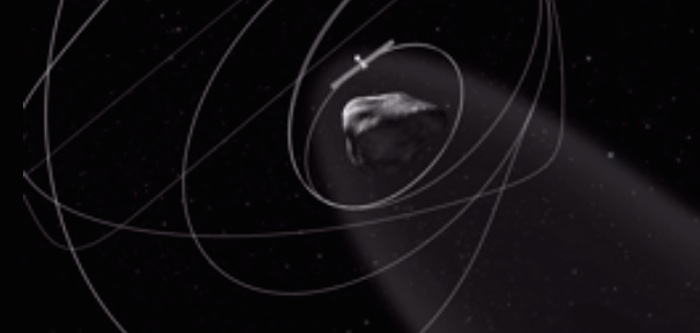
Under the new cycle, for the Wednesday burn, Mondays will be the planning day (for Sunday burns, it will be Thursday). Planning day means an intense round of activity not only for the FCT, but also for the FLIGHT dynamics teams.
Late in the day, by 20:00CEST, flight dynamics will deliver all their PRODUCTS required for the coming cycle (based on their analysis of the resulting orbit and the preceding burns) to the FCT, who will merge this with other products (including instrument activities coming from the Rosetta Science Operations Centre at ESAC – see comment at end), make sure all activities are conflict free and generate the stack of commands that must be uploaded to carry it all out.
The FCT are also busy generating plans and data related to the ground stations and other systems used to control Rosetta. This involves a great deal of checking, cross-checking and time-line updating, as WELL as resolving any conflicts that are found.
To get an idea of how TIGHT the schedule is, note that the set of commands on board Rosetta now expire at 12:00 CEST Tuesday, 5 August. In other words, if nothing else is done, Rosetta would run out of instructions tomorrow at lunch time!
So, the next set of commands, including the Wednesday burn commands, must be readied and then uploaded tonight overnight.
This next set will cover the timeframe 12:00 CEST Tuesday to 12:00 CEST Friday. The CYCLE then repeats for the Sunday burn.
And this very brief description relates only to the FCT activities; in parallel, the ROSETTA Science Operations Centre at ESAC must also generate a complex set of instructions for the instruments, which also must be planned and uploaded on a very tight schedule.
.
Quelle: ESA
.
Update: 18.00 MESZ
.
COMETWATCH – 3 AUGUST
ROSETTA navigation camera (NAVCAM) image taken on 3 August 2014 at about 300 km from comet 67P/C-G. The Sun is towards the bottom of the image in the depicted orientation.
The window size for today's sub-image is 400 x 400 pixels and the FACTOR for scaling up and interpolation is 2. The contrast adjustment is no longer applied since the shadows provide enough contrast now.
Like yesterday, we also show today for comparison both the crop of the interpolated and non-interpolated versions.
This view certainly shows off yet more of the comet's interesting surface!
.
Full-frame NAVCAM image taken on 3 August 2014 from a distance of about 300 km from comet 67P/Churyumov-Gerasimenko.
.
Crop from the 3 August processed image of comet 67P/Churyumov-Gerasimenko.
.
Crop from the 3 August image of comet 67P/Churyumov-Gerasimenko.
Quelle: ESA
.
Update: 5.08.2014
.
COMETWATCH – 4 AUGUST
Rosetta navigation camera (NAVCAM) image taken on 4 August 2014 at about 234 km from comet 67P/C-G.
As you can see, the comet is not centred in the full-frame image. This is a result of the rendezvous burn conducted the previous day, which adjusted Rosetta's trajectory towards the comet. This effect is corrected for in the commands sent to the spacecraft after the new orbit has been determined.
The window size for today's sub-image is 400 x 400 pixels and the factor for scaling up and interpolation is 2 (like yesterday).
From tomorrow the nucleus should be large enough to provide the full-frame image only!
.
Full-frame NAVCAM image taken on 4 August 2014 from a distance of about 234 km from comet 67P/Churyumov-Gerasimenko
.
Crop from the 4 August processed image of comet 67P/Churyumov-Gerasimenko.
Quelle: ESA
.
Update: 21.40 MESZ
.
A timeline of the most crucial steps leading to ROSETTA’s arrival at its target comet on Wednesday. Mission operations and science teams at ESA and scientists from multiple countries will be following progress closely.
After completing a complex series of nine ORBITAL manoeuvres since the end of hibernation on 20 January, Rosetta is finally in position to rendezvous with the comet.
Orbit entry will take place on 6 August, and will be triggered by a small but crucial thruster firing lasting just 6 min 26 sec, starting at 09:00 GMT (11:00 CEST). The commands were uploaded during the night of 4 August.
This burn will tip Rosetta into the first leg of a series of three-legged triangular paths about the comet. The legs will be about 100 km long and it will take Rosetta between three and four days to complete each one.
Orbit entry timeline
5 August
| GMT/CEST |
EVENT |
Details |
| 08:04/10:04 |
BoT New Norcia tracking station |
ESA 35 m station, Australia |
| 19:41/21:41 |
EoT New Norcia tracking station |
|
| 20:00/22:00 |
BoT DSS-63 tracking station |
NASA 70 m station Madrid |
6 August
| GMT/CEST |
Event |
Details |
| 00:05/02:05 |
EoT DSS-63 |
|
| 00:10/02:10 |
BoT Malargüe tracking station |
ESA 35 m station, Argentina |
| 02:41/04:41 |
EoT Malargüe |
|
| 02:50/04:50 |
BoT DSS-15 |
NASA 34 m station, Goldstone, USA |
| 07:35/09:35 |
EoT DSS-15 |
|
| 08:00/10:00 |
BoT New Norcia tracking station
AoS telemetry DATA flow (see below) |
|
| |
ROSETTA slews into position for thruster burn |
| 09:00:01/11:00:01 |
Start: Comet Approach Trajectory – insertion thruster burn |
Start of ORBIT entry manoeuvre. Must wait 1-way light time for confirmation on ground |
| 09:06:27/11:06:27 |
End: thruster burn |
Rosetta now on first LEG of cometary orbit |
| |
Rosetta slews back to comet-pointing mode |
| 09:22:30/11:22:30 |
Start of thruster burn confirmed on ground |
|
| 09:28:56/11:28:56 |
End of thruster burn confirmed on ground |
|
| 19:43/21:43 |
EoT New Norcia |
|
| 19:48/21:48 |
BoT Malargüe tracking station |
|
.
Update: 6.08.2014
.
Rosetta vor Kometen-Orbit
.
.
...
.
...
...
...
.
.
.
Quelle: ESA
.
Update: 23.00 MESZ
.
“Hello, Comet!”
.
Last but definitely not least, the programme switched back to Sylvain Lodiot and to Andrea Accomazzo, ESA Rosetta Flight Director, who both explained more details about today's manoeuvre and the rendezvous.
Finally, at 09:02:29 UTC on board Rosetta, the final burn ended, meaning that Rosetta has arrived at her destination. "We are at the comet," announced a jubilant Sylvain Lodiot to the delight of the large crowd following the EVENT at ESOC, around 11:29 CEST.
Arriving at comet 67P/Churyumov-Gerasimenko is an historic moment for this remarkable mission. The morning programme closed with remarks of accomplishment and excitement by Mark McCaughrean, Senior Scientific Advisor, ESA Directorate of Space and Robotic Exploration, ESA Director General Jean-Jacques Dordain and Álvaro Giménez, ESA Director of Science and Robotic Exploration.
.
POSTCARDS FROM ROSETTA
The images confirm it: Rosetta has now really arrived at Comet 67P/Churyumov-Gerasimenko! Holger Sierks from the OSIRIS team just presented two new views of the comet in stunning close up detail at the afternoon session of the Rosetta arrival event at ESOC, in Darmstadt.
.
Close-up detail of comet 67P/Churyumov-Gerasimenko
.
This image, focusing on a smooth region on the ‘base’ of the ‘body’ section of comet 67P/C-G, was taken by ROSETTA’s OSIRIS narrow-angle camera and downloaded today, 6 August 2014.
The image clearly shows a range of features, including boulders, craters and steep cliffs. It was taken from a distance of 130 km and the image resolution is 2.4 metres per pixel.
Another close-up detail shows the comet’s ‘head’ at the left of the frame, which is CASTINGshadow onto the ‘neck’ and ‘body’ to the right. This image was taken from a distance of 120 km and the image resolution is 2.2 metres per pixel.
.
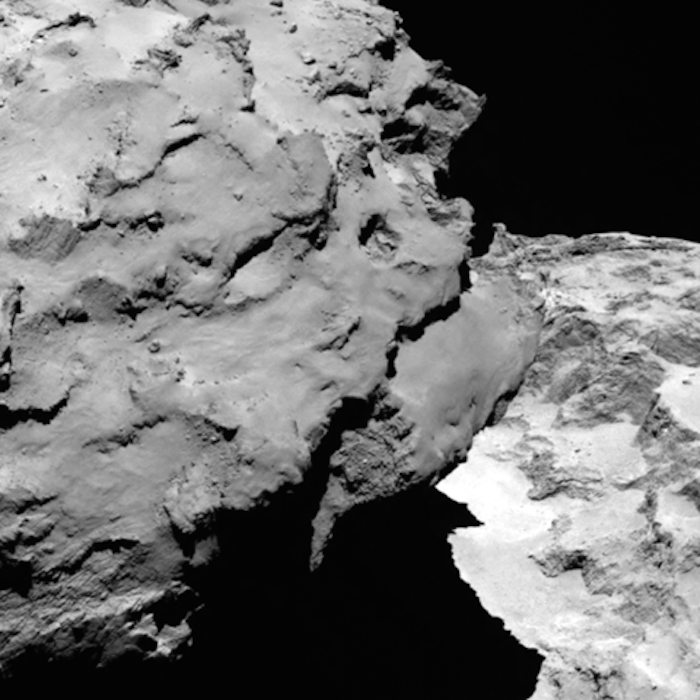
Another close-up view of the comet. Credits: ESA/Rosetta/MPS for OSIRIS Team MPS/UPD/LAM/IAA/SSO/INTA/UPM/DASP/IDA
.
.
.
Comet activity on 2.08.2014
QUELLE: ESA
.
Update: 7.08.2014
.
Rosetta comet rendezvous is a triumph for the European Space Agency
Rosetta has arrived at Comet 67P/Churyumov-Gerasimenko. One of the most audacious space missions in decades, it is designed to reveal clues to the origins of the solar system, our home planet and life itself
.
Holger Sierks, lead scientist for Rosetta's imaging system, reveals fresh imagery of comet 67P/Churyumov-Gerasimenko to media and VIPs
.
Holger Sierks, lead scientist for Rosetta's imaging system, reveals fresh imagery of comet 67P/Churyumov-Gerasimenko
.
Holger Sierks, lead scientist for Rosetta's imaging system, reveals fresh imagery of comet 67P/Churyumov-Gerasimenko
.
Holger Sierks, lead scientist for Rosetta's imaging system, reveals fresh imagery of comet 67P/Churyumov-Gerasimenko
.
Potential landing areas for Rosetta's Philae lander are shown in green. The other colors represent brightness, with the red areas being the brightest.
.
A view of outgassing from comet 67P/Churyumov-Gerasimenko super-imposed on an image from Rosetta's OSIRIS camera. This is a photo taken of the image displayed on a television screen.
.
This morning, a thruster burn brought Rosetta into “orbit” around its target comet, signalling the start of its main science phase. The spacecraft will now track comet 67P/Churyumov-Gerasimenko for a year, following it through its closest approach to the sun to monitor how the extra heating affects the icy surface.
Nothing about this mission is ordinary, and these are no ordinary orbits. The weirdly shaped comet, which some have likened to the shape of a rubber duck, does not produce enough gravity to fully hold the spacecraft. Instead, the flight team will “drive” the spacecraft in triangular-shaped orbits, gradually lowering the altitude from today’s 100km to around 30km.
One of the most audacious space missions in decades, it is designed to reveal secrets about the origin of the solar system, the origin of our home planet and even the origin of life.
From a PR point of view, today’s triumphant rendezvous stands in stark contrast to the last time the European Space Agency mounted a comet mission. That was back in 1986. The mission was called Giotto and the comet was the famous one named after Edmond Halley, the 18th century astronomer who predicted its return.
Back then, the venerable TV astronomer Patrick Moore and James Burke conducted a live programme to bring the first pictures of the comet to the British public as they were received. Moore was in Darmstadt, Germany, where Esa’s mission control is located, and Burke was in London.
Viewers were promised the first ever view of the nucleus of a comet – the mountainous iceberg that evaporates to give the ghostly tails for which comets are famous.
The snag was that when the pictures arrived they were incomprehensible. They were garishly colour-coded, and not even the experts could interpret them. No one knew at the time the beauty of the comet that would be revealed by subsequent analysis.
Then, just around the time of closest approach, the signal from the spacecraft disappeared. The guests were left with no recourse but to speculate about whether Giotto could have been destroyed by the dust and debris coming off the nucleus. It makes uncomfortable, embarrassing watching even today.
But, if the stories are true, the damage was much worse than a few red faces. It is now a piece of space folklore that UK prime minister Margaret Thatcher was watching. She was so appalled by what she perceived to be a total waste of money that she began a severe tightening of the UK’s purse strings where Esa and space research were concerned.
That has now turned around completely with the UK being a committed investor in the space sector. The other thing that has turned around is the way science is communicated to the public.
This morning there were no red faces; just fantastic images, fantastic data and the promise of more fantastic science to come. Read the official statement from Esa here.
.
After a decade-long journey chasing its target, ESA’s Rosetta has today become the first spacecraft to rendezvous with a comet, opening a new chapter in Solar System exploration.
Comet 67P/Churyumov–Gerasimenko and Rosetta now lie 405 million kilometres from Earth, about half way between the orbits of Jupiter and Mars, rushing towards the inner Solar System at nearly 55 000 kilometres per hour.
The comet is in an elliptical 6.5-year orbit that takes it from beyond Jupiter at its furthest point, to between the orbits of Mars and Earth at its closest to the Sun. Rosetta will accompany it for over a year as they swing around the Sun and back out towards Jupiter again.
Comets are considered to be primitive building blocks of the Solar System and may have helped to ‘seed’ Earth with water, perhaps even the ingredients for life. But many fundamental questions about these enigmatic objects remain, and through a comprehensive,in situstudy of the comet, Rosetta aims to unlock the secrets within.
The journey to the comet was not straightforward, however. Since its launch in 2004, Rosetta had to make three gravity-assist flybys of Earth and one of Mars to help it on course to its rendezvous with the comet. This complex course also allowed Rosetta to pass by asteroids Šteins and Lutetia, obtaining unprecedented views and scientific data on these two objects.
“After ten years, five months and four days travelling towards our destination, looping around the Sun five times and clocking up 6.4 billion kilometres, we are delighted to announce finally ‘we are here’,” says Jean-Jacques Dordain, ESA’s Director General.
“Europe’s Rosetta is now the first spacecraft in history to rendezvous with a comet, a major highlight in exploring our origins. Discoveries can start.”
Today saw the last of a series of ten rendezvous manoeuvres that began in May to adjust Rosetta’s speed and trajectory gradually to match those of the comet. If any of these manoeuvres had failed, the mission would have been lost, and the spacecraft would simply have flown by the comet.
“Today’s achievement is a result of a huge international endeavour spanning several decades,” says Alvaro Giménez, ESA’s Director of Science and Robotic Exploration.
“We have come an extraordinarily long way since the mission concept was first discussed in the late 1970s and approved in 1993, and now we are ready to open a treasure chest of scientific discovery that is destined to rewrite the textbooks on comets for even more decades to come.”
The comet began to reveal its personality while ROSETTA was on its approach. Images taken by the OSIRIS camera between late April and early June showed that its activity was variable. The comet’s ‘coma’ – an extended envelope of gas and dust – became rapidly brighter and then died down again over the course of those six weeks.
In the same period, first measurements from the Microwave Instrument for the Rosetta Orbiter, MIRO, suggested that the comet was emitting water vapour into space at about 300 millilitres per second.
Meanwhile, the Visible and Infrared Thermal Imaging Spectrometer, VIRTIS, measured the comet’s average temperature to be about –70ºC, indicating that the surface is predominantly dark and dusty rather than clean and icy.
Then, stunning images taken from a distance of about 12 000 km began to reveal that the nucleus comprises two distinct segments joined by a ‘neck’, giving it a duck-like appearance. Subsequent images showed more and more detail – the most recent, highest-resolution image was downloaded from the spacecraft earlier today and will be available this afternoon.
“Our first clear views of the comet have given us plenty to think about,” says Matt Taylor, ESA’s Rosetta project scientist.
“Is this double-lobed structure built from two separate comets that came together in the SOLARSystem’s history, or is it one comet that has eroded dramatically and asymmetrically over time? Rosetta, by design, is in the best place to study one of these unique objects.”
Today, ROSETTA is just 100 km from the comet’s surface, but it will edge closer still. Over the next six weeks, it will describe two triangular-shaped trajectories in front of the comet, first at a distance of 100 km and then at 50 km.
At the same time, more of the suite of instruments will provide a detailed scientific study of the comet, scrutinising the surface for a TARGETsite for the Philae lander.
Eventually, Rosetta will attempt a close, near-circular ORBIT at 30 km and, depending on the activity of the comet, perhaps come even closer.
“Arriving at the comet is really only just the beginning of an even bigger adventure, with greater challenges still to come as we learn how to operate in this unchartered environment, start to orbit and, eventually, land,” says Sylvain Lodiot, ESA’s Rosetta spacecraft operations manager.
As many as five possible landing sites will be identified by late August, before the primary site is identified in mid-September. The final timeline for the sequence of EVENTS for deploying Philae – currently expected for 11 November – will be confirmed by the middle of October.
“Over the next few months, in addition to characterising the comet nucleus and setting the bar for the rest of the mission, we will begin final preparations for another space history first: landing on a comet,” says Matt.
“After landing, Rosetta will continue to accompany the comet until its closest approach to the Sun in August 2015 and beyond, watching its behaviour from close quarters to give us a unique insight and realtime experience of how a comet works as it hurtles around the Sun.”
.
Now that ROSETTA has reached comet 67P/C-G, it's time to unlock this icy treasure chest. Comets hold many secrets about the birth and evolution of the SOLAR SYSTEM, but also about the origin and history of many molecules that are fundamental for life on Earth – to name just one, water.
The broad range of instruments on board Rosetta will now investigate the surface and environment of 67P/C-G's nucleus in unprecedented detail. Some have already started to do so from afar, producing scientific results that were presented during this afternoon's session at the Rosetta Rendezvous event in ESOC, Darmstadt.
Getting to know the comet in greater detail is a necessary step to get any closer to it, which is in turn key to achieve a global mapping of the comet's nucleus. Frank Budnik, FLIGHT Dynamics expert at ESA, described the manoeuvres entailed in this initial characterisation phase.
While Rosetta flies through the first two “triangles”, the flight dynamics engineers at ESA will gather information to improve their estimate of the comet's mass. Knowing the mass is necessary to plan further steps and get into orbit around the comet.
The following phase is the global mapping, during which the team plans to map at least 80 per cent of the comet's surface. Eventually, ROSETTA will go even closer – between 10 and 30 km – for the close observation phase, to start identifying landing sites.
A brief overview of what's coming next from the Science Ground Segment was provided by Laurence O'Rourke from the Rosetta Science Operations team at ESA. Centralised planning is a must to coordinate the operations of the 11 instruments on board Rosetta and to maximise the science they will perform.
.
A simulated view of Rosetta and where it's pointing, with the different fields of view of various instruments highlighted. From L. O'Rourke's presentation.
.

Stefan Ulamec showing a colour-coded shape model of the comet.
.
As the latest images from OSIRIS make clear, choosing a landing site for Philae will not be easy. In the afternoon session of the ROSETTArendezvous event at ESOC today, Stefan Ulamec, Philae Lander Manager from DLR, talked about some of the challenges that will be facing the team.
One challenge will be landing in low gravity. This was tested at the Max Planck Institute in Katlenburg-Lindau before launch.
Later, tests were carried out at the Landing and MOBILITY Test Facility (LAMA) of DLR in Bremen, where landing in sandy conditions and on different slopes could be assessed using the qualification model of the Philae lander.
Another fear when the lander was being designed was that it would rebound from the surface – but this was when they still thought the surface would be very hard. Indications now are that surface appears to be soft so Ulamec thinks that rebounding won't be such an issue. We’ll soon find out what the surface is made of, but in any case, the lander is equipped with a harpoon system and ice screws to secure it to the surface. In addition, the touchdown will be at a speed of just 1 m/s - Ulamec described: “this is like walking and bouncing against a wall; it hurts but it won't kill you!”
But what about the surprising comet shape? Not the standard ‘potato’ that everyone was expecting – more like two potatoes stuck together, or even a duck. Already, there has been a very preliminary analysis carried out at CNES showing some potentially interesting sites based on the illumination conditions and FLIGHT dynamic restrictions.
But now it's time to start the process for real: the landing site selection group will meet for their first full meeting 22-24 August, at which stage they will select a maximum of 5 candidate landing sites.
Quelle: ESA
